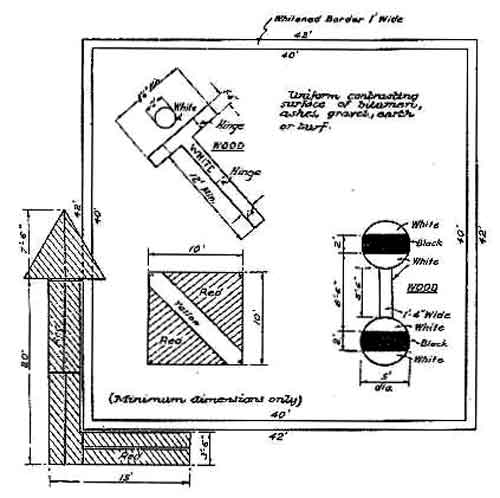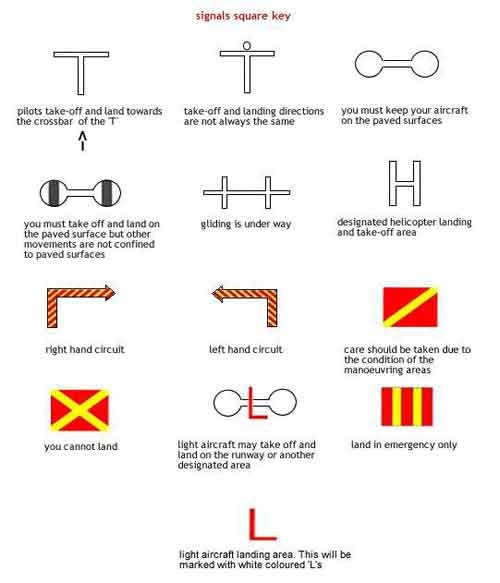The Signal Square & Other Visual Signals to Aircraft
by Roger Meyer
The Signal Square was neither fish nor fowl. It was installed and maintained at aerodromes by Airports staff,
and operated by the resident groundsman or airport fireman on the instruction of the air traffic controller or flight
service officer.
The Signal Square, or signal area, contained symbols to indicate visually to over-flying aircraft conditions
on the aerodrome. It had pre-War origins, and was intended for aircraft that carried no radio communications equipment
(which included most light aircraft well into the 1960s). As soon as ICAO was created in 1947, Annexe 14 contained
(and still does) instructions on the size and construction of the Signal Square. Annex 2 describes its use by aircraft.
Ground signals are still used at aerodromes to this day - the landing T and the gliding-in-operation symbol being the
most common ones, but the general use of the signal square had fallen into disuse by the late 1950s when VHF air-ground
communications had been largely introduced.
The square was marked out on the ground in the vicinity of the control tower and the wind-sock. It had sides 40
feet long, with a white-painted border. The surface inside the square was smooth and level, surfaced in bitumen, ashes,
sealed gravel, turf or even bare earth. It was usually blackened with sump oil or black ashes to provide a contrasting
background to the symbols that conveyed the information. The were four basic signals; the red square signal, the dumb
bell signals, the landing T, and the right hand circuit indicator. All of these objects were made of timber and
painted black on the reverse side. They were made of a series of hinged sections so that they could be folded up when
not in use, and would not be visible from the air as the reverse side was showing, and appeared black.

The function of these elements was as follows.
Red Signal Square:
A red square with no diagonals indicated that the aerodrome rules were temporarily suspended, and that special
arrangements were in operation. If this square had one yellow diagonal cross-bar, it indicated that the bad state
of the landing ground or a temporary obstruction required caution by the pilot when landing. If the Red Square had
two yellow diagonal cross-bars, this meant a total prohibition of landing for a prolonged period. Two vertical
yellow bars across the red square means land in an emergency only.
Dumb Bell Signals:
These were only displayed only on aerodromes with sealed runways. A white dumb bell indicated that the
airfield surface was unserviceable except for the runways and that take-offs and landings were to be made on
the runways only, and that all taxying must be on paved surfaces only. A white dumb bell with black bars
superimposed across the centres of each circular portion of the dumb bell meant that landings and take-offs
must be on runways only, but grass surfaces may be used for taxying, subject to standard serviceability markings.
A red "L" on the dumb bell indicated that light aircraft may land or taxi off the runways, but that heavy
aircraft must use runways only.
Landing 'T':
This was probably the best known of the signals, and was used at all-over landing fields. It was mounted
on a pivot for ease of turning, and supported on castor wheels or skids. It was lined up with the wind
direction, and an aircraft landed along the shaft of the "T" towards the cross arm. While not commonly used,
a white disc at the centre of the cross piece of the "T" indicated that take-offs and landings were being made
in more than one direction, and that pilots must be 'on the alert'. Of course, the air traffic controller or
Aeradio operator on-duty had to be vigilant, and change the direction of the T whenever the wind direction changed.
White Cross:
This symbol indicated that parachute dropping was in progress, and that aircraft were not to take-off or
land.
Double White Cross:
This symbol, a vertical arm with two parallel cross arms, is still in use at some aerodromes and indicates
that glider flying is in progress.
Right Hand Circuit Arrow:
If right hand circuits were to be used by aircraft instead of the normal convention of left-hand circuits
a large red arrow, bending right, was employed. It was superimposed on two adjacent sides of the Signal Area,
in close proximity to the horizontal red square panel.
There were some other symbols used only at military airfields, for obvious reasons.
A white hollow square indicated bombing practice with dummy bombs and diving practice were being carried
out, with a white square as the bombing target.

TOWER SIGNALS
While not directly related to the signal square, it is worth recording here several other aerodrome
conditions that could be conveyed to aircraft via symbols mounted on the control tower. These were the
Airport Altitude Sign in 8" high letters, and above it was the duty Runway or landing Strip Number Sign
(eg, runway 09).
Cane balls could also be raised and lowered on a gantry above the tower cabin. A raised yellow ball
indicated that the Aerodrome Control Officer was not in attendance. The black ball was called the 'no wind'
signal, and indicated that the take-off direction was to be verified with the Aerodrome Control Officer.
These symbols had generally fallen into disuse soon after the war.
|







